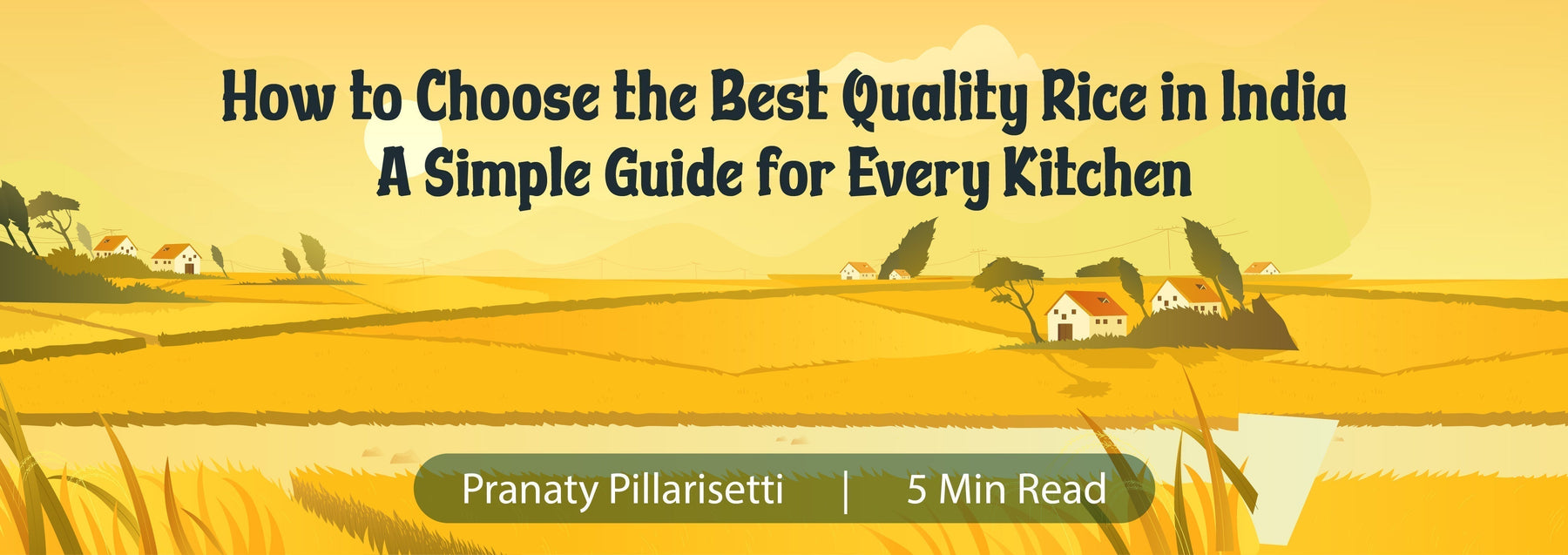
How to Choose the Best Quality Rice in India - A Simple Guide for Every Kitchen
A Grain of Truth in Every Bowl
A comfort, feeling of belonging and even an expression of care in many Indian households is rice. So, it's not just food. Some prefer the soft, everyday familiarity of Sona Masoori, while others save aromatic Basmati for weekend biryanis. And there are those who choose red, unpolished varieties like Rajamudi or Navara, not only for their taste but also for their health benefits and the way they honor the land and the ancestry that they came and grew in.
But in today’s market, with shiny packets, “premium” labels, and prices that sometimes feel like a luxury, choosing the right rice can be overwhelming. How do you know which rice is genuinely worth bringing home? How do you separate marketing from quality, or tradition from trend?
Whether you shop online or in your local kirana store, knowing what defines high-quality rice in India can change your meals, your gut, and even your impact on the environment.
What Makes Rice “High Quality”?
Contrary to popular belief, the length, color, or glossy shine of rice grains does not define their quality. Nor is it just about brand reputation or price. High-quality rice is about purity, nutrition, and the way it’s grown and the way it digests after consumption. It’s rice that respects the soil, grows without harmful chemicals, and retains its natural taste and aroma. Lets discuss a few attributes that make a rice High quality.!
A quality grain is uniform in size, clean, and free from starch dust or hidden mixes. Over-polished grains often strip away nutrition, sometimes hiding additives that aren’t visible on the surface. If you look at a packet and it seems “too white,” take a pause because the shine may be masking the loss of nutrients and flavor.
2. Pesticide-Free and Organic Practices
Mass-produced rice in India often relies on synthetic fertilizers and pesticides. Over time, residues from these chemicals end up on our plates, affecting our health as well as depleting our soil, water, and biodiversity. This is why organic farming isn’t just a “label”, it’s a conscious step towards food that’s safe, nourishing, and grown in harmony with nature. At Rajamudi Organics , our rice is grown naturally, without synthetic inputs, letting the soil and the grain thrive together. Every harvest is regenerative, not extractive.
3. Aroma and Natural Taste
High-quality rice carries the fragrance of the land it comes from. Think of the delicate mango-blossom scent of Ambe Mohar or the earthy aroma of Rajamudi. This isn’t added flavoring, it’s the grain’s own character, developed slowly in healthy soil. Artificial polishing or chemical treatments can dull or erase this natural aroma.
4. Nutritional Integrity
The less a rice grain is polished, the more of its fibre, iron, and antioxidants it retains. Red, black, and semi-polished varieties pack far more nutrition than highly polished white rice. When choosing rice, remember: looks can deceive, but the body always knows what’s real.
5. Cooking Performance
Good rice isn’t just about how it looks raw, it’s about how it behaves when cooked. A high-quality grain cooks evenly, doesn’t break apart too much, and retains a pleasing texture. Whether it’s fluffy basmati , soft Sona Masoori , or the chewy bite of unpolished varieties, the true test of quality is in the pot and on the plate.
Organic vs Conventional Rice: Understanding the Difference
At first glance, rice is rice - white, long, and neatly packed. But the way it’s grown makes all the difference. Conventional rice is produced for volume and uniformity, often prioritizing yield over nourishment. In this process, grains lose much of their natural character and depth of nutrition.
Organic rice, especially traditional varieties like Rajamudi, grows in a system that values soil life, crop diversity, and balance. The grains that come out of this system are often called regenerative grains because they carry the benefits of farming practices that restore ecosystems instead of exhausting them. They retain fiber, minerals, and a natural aroma that polished varieties cannot match. This difference isn’t cosmetic, it’s about integrity from farm to plate.
It’s true that organic rice can cost more than regular packets on a supermarket shelf. But that price includes something hidden in every grain: respect for the farmer’s effort, regeneration of the land, and a healthier plate for the consumer. When you buy organic, you’re not paying extra for packaging, you’re paying for honesty, heritage, longevity, your health, and sustainity of future generations.
India’s Diverse Rice Heritage
Now that we’ve seen how organic and conventional rice differ, let’s talk about something most of us forget while picking rice: India’s own heritage of grains. Supermarkets may show only a few shiny varieties, but India is home to more than 6,000 native rice varieties. Hidden in this diversity are grains that are richer in nutrition, easier on digestion, and far more authentic than their polished counterparts.
Take Rajamudi Rice, for instance. Once reserved for royalty in Karnataka, it comes with a natural reddish hue and remains unpolished, preserving its fiber and minerals. Its firm bite and earthy flavor make it a favorite for families seeking everyday meals that are both wholesome and low on the glycemic index.
Travel south, and you find Navara Rice from Kerala, a rare Ayurvedic grain, soft and mildly sweet, known for its healing properties. Traditionally used in porridges and recovery diets, Navara is gentle enough for children yet nourishing enough for therapeutic cooking.
Maharashtra offers Ambe Mohar, a delicate short-grain rice with a faint mango blossom aroma. It cooks quickly and carries a subtle sweetness, perfect for pulavs, baby food, or light meals that don’t weigh you down.
From the heart of Andhra and Karnataka comes the traditional Sona Masoori is light, fluffy, and easy to digest. But here’s the difference: the original semi-polished Sona Masoori that we grow at Rajamudi Organics is not the over-processed version you often find. It retains its authenticity, making it a true daily comfort grain. Alongside it, our Diabetic Rice , with a naturally low glycemic index, offers stability for those managing sugar levels while keeping the joy of rice intact.
And the journey doesn’t end there. Indrayani from Maharashtra, fragrant yet fibrous; Red Rice varieties, rich in antioxidants; and Black Rice , once called “forbidden rice,” dense with iron and anthocyanins, each grain adds to India’s mosaic of diversity. Some are unpolished, keeping their bran layer intact, while others are semi-polished for a balance of taste and nutrition.

So when you’re standing in front of a rice shelf, remember: the best quality isn’t always the whitest grain. Sometimes it’s the earthy red, the fragrant short-grain, or even the deep black each carrying a story of soil, farmer, and heritage.
How to Judge the Quality of Rice
Now that we’ve explored India’s rice heritage and the richness of traditional varieties, the next big question is: how do you actually judge rice quality when buying for your family?
The truth is, glossy packaging can’t tell you everything. Whether you’re picking rice at the local market or ordering online, here are a few simple markers to guide you:
Judging rice this way doesn’t just save you from disappointment in the kitchen; it ensures you’re truly getting the health benefits and authenticity you’re paying for.
How to Choose the Best Rice for Your Kitchen - Rajamudi Organics Guide
Buying rice isn’t just about picking the packet with the shiniest grains or the biggest discount. The real question is: what does your family need most from rice? At Rajamudi Organics , we’ve seen that every household has different priorities some want comfort and everyday ease, others want nutrition and health support, while some love experimenting with traditional varieties.
Here’s how we guide our customers to make the right choice:
1. For Everyday Comfort Meals
If rice is the heart of your daily plate, you need a grain that cooks soft, light, and easy to digest. Sona Masoori semi-polished or brown and Rajamudi Rice are our most recommended varieties for this. Sona Masoori gives that homely, fluffy texture without being heavy, perfect for daily meals. Rajamudi adds fibre and minerals, supporting satiety and a balanced diet.
2. For Ayurvedic Healing & Wellness
For families who care about digestive health, immunity, and traditional wellness, Navara Rice is ideal. Prized in Ayurveda, it supports recovery, improves digestion, and can be used in porridges, kheer, or medicinal preparations. This grain is gentle on the system yet rich in nutrients, making it a staple for mindful, health-focused kitchens.
3. For Blood Sugar Balance & Weight Management
If you’re managing conditions like diabetes, PCOS, or simply aiming to eat lighter, opt for Diabetic Rice , Red Rice or Brown Sona Masoori . These varieties release energy slowly, keeping you full and steady. They’re proof that rice doesn’t need to be avoided for health reasons — you just need to choose the right type.
4. For Aromatic & Light Dishes
When you want your meals to feel special without being heavy, reach for Ambe Mohar , Indrayani , or Basmati. Their soft texture and subtle fragrance make them perfect for pulavs, biryanis, khichdis, or light everyday meals. Quick-cooking and naturally aromatic, they bring a refined touch to regular cooking while elevating weekend or festive dishes.
5. For Exploring Nutrition & Variety
Sometimes, the best choice is to surprise your plate. Black Rice or antioxidant-rich Red Rice varieties bring colour, micronutrients, and variety to your table. They may not be your everyday grain, but introducing them once or twice a week keeps your meals exciting and nutrient-dense.
Rajamudi’s Simple Suggestion
Don’t lock your kitchen into just one kind of rice. Keep at least two or three varieties at home:
This balance ensures your meals stay versatile, nourishing, and rooted in India’s heritage of grains.
Bringing It All Together: Choosing the Best Quality Rice for Your Kitchen
Rice is more than just a staple; it’s a thread connecting generations, health, and culture. By now, you know that “high quality” isn’t just about shiny grains or fancy labels, it’s about purity, nutrition, natural aroma, cooking performance, and ethical, regenerative farming.
Whether you favor everyday comfort with Sona Masoori, the fiber-rich depth of Rajamudi, the Ayurvedic wellness of Navara, the aroma of Ambe Mohar, or the slow-energy release of Red and Diabetic Rice, the right choice depends on your family’s needs, lifestyle, and values.
At Rajamudi Organics, every grain tells a story of farmers tending soil with care, of heritage preserved through generations, and of food that nourishes body and soul alike. Choosing rice thoughtfully isn’t just about the meal on your plate; it’s about the health of your family, the sustainability of the land, and the respect for those who grow it.
So next time you stand in front of a rice shelf, ask yourself:
When the answer is yes, you’re not just buying rice, you’re making a choice that matters, one grain at a time.



